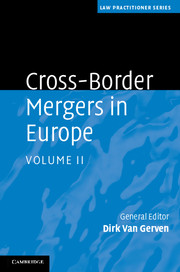Book contents
24 - Latvia
from Part V - Application in each Member State
Published online by Cambridge University Press: 07 October 2011
Summary
Introduction
The Cross-border Merger Directive required Member States to implement the Directive by 15 December 2007. While the Republic of Latvia failed to meet that deadline, the delay in implementation was not of substantial duration. On 6 March 2008, the Parliament adopted amendments to the Law on the Register of Enterprises of the Republic of Latvia and on 24 April 2008 amended the Commercial Law to incorporate the legal framework enabling cross-border mergers between companies within the European Economic Area (EEA). The Parliament further amended the Commercial Law, precisely Chapter XIX, on 28 May 2008 to establish a specific legal facility to govern cross-border mergers: ‘Special Provisions Related to Cross-Border Mergers’.
The Cross-border Merger Directive enables limited liability companies registered in different Member States of the EEA to merge and continue activity as a simple company of the Member State where the surviving company is established. In Latvia, the amended Law on the Register of Enterprises of the Republic of Latvia created a legal basis for the Register of Enterprises to register a cross-border merger when the surviving company is resident in Latvia, or, ‘if the acquiring company is registered in another member state, to carry out a legality check of the merger and to issue a pre-merger certificate’ (Art. 43 Law on the Register of Enterprises of the Republic of Latvia). Amendments to the Commercial Law established the procedural framework.
- Type
- Chapter
- Information
- Cross-Border Mergers in Europe , pp. 63 - 73Publisher: Cambridge University PressPrint publication year: 2011
- 1
- Cited by



